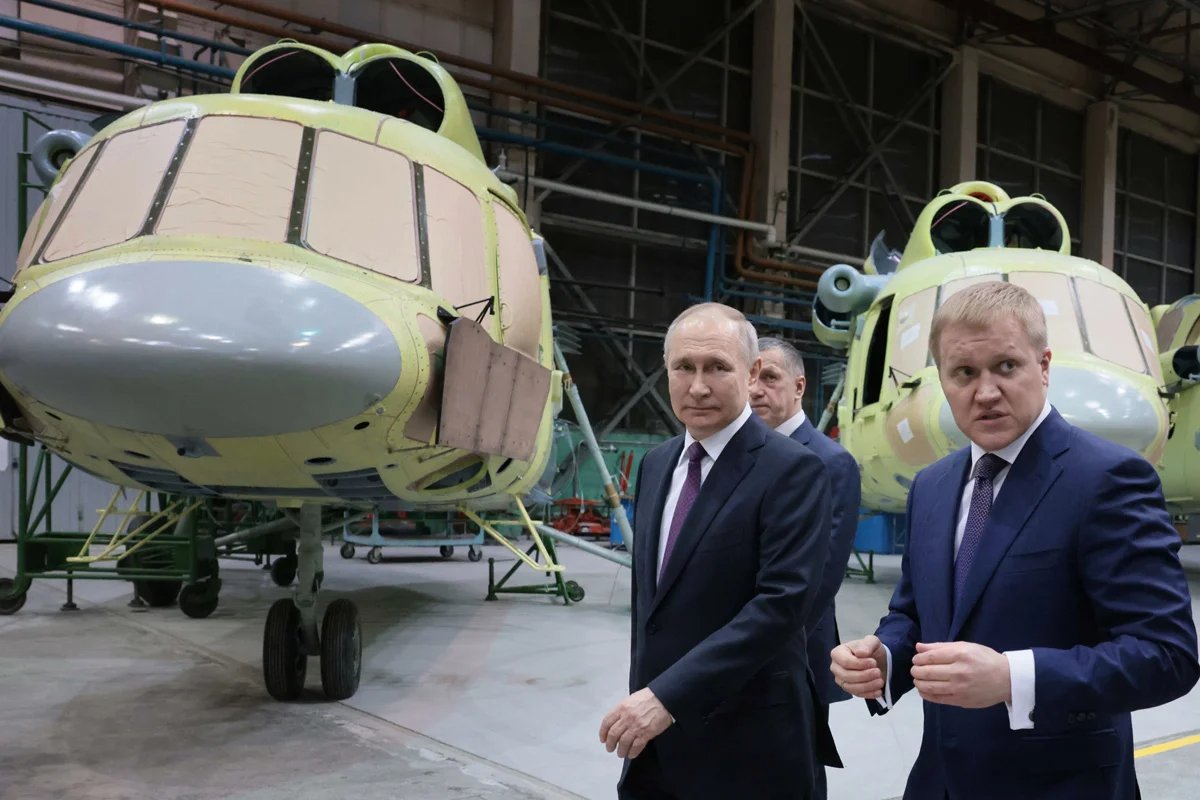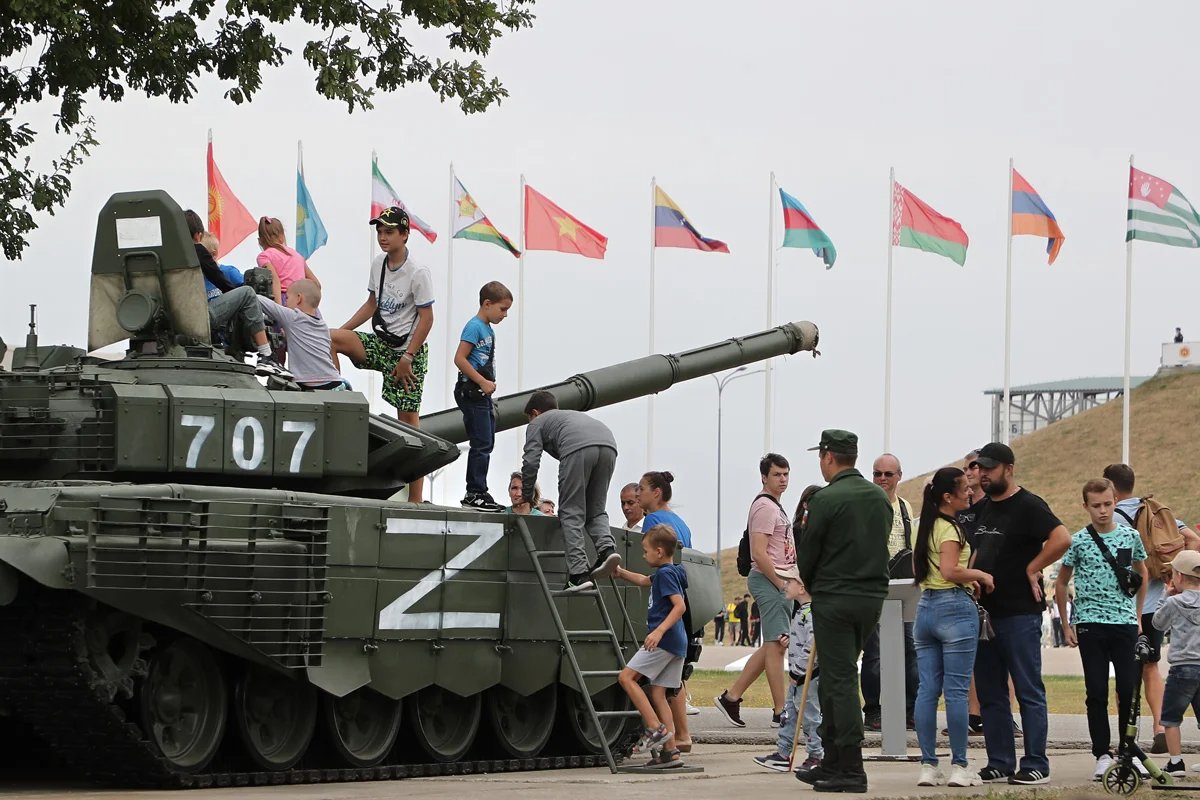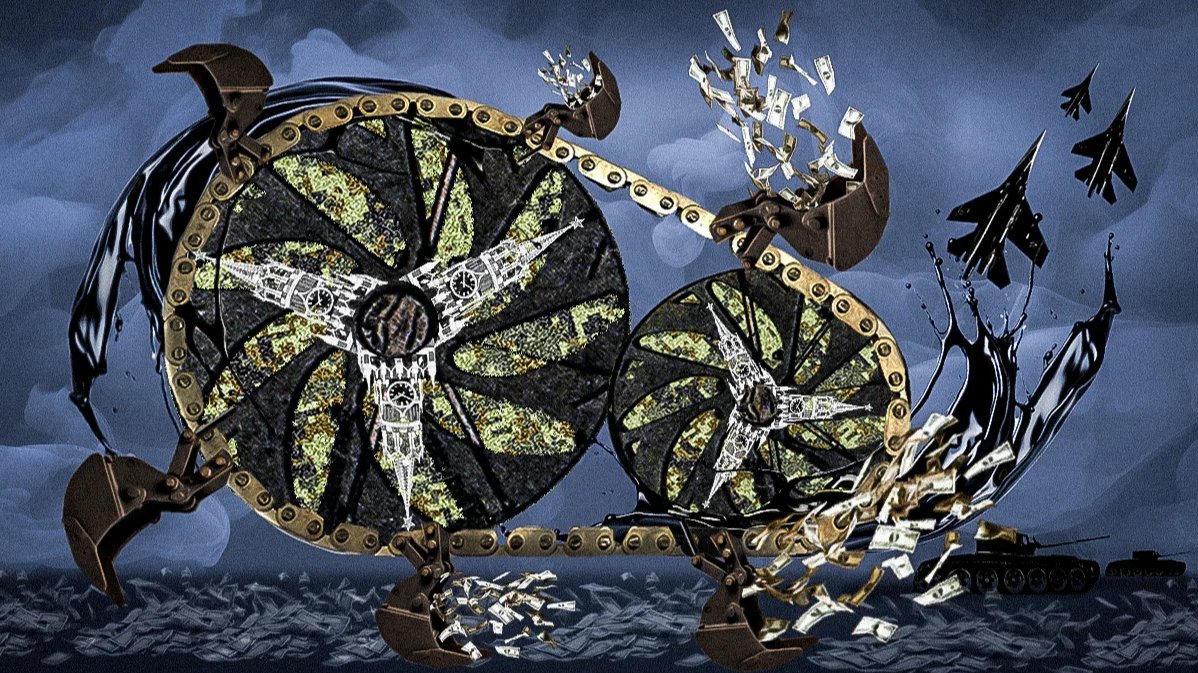As Russia enters its third year of war in Ukraine, the Kremlin shows no sign of running out of money, and so far the economy is coping with replenishing the war budget while trying to fulfil Vladimir Putin’s electoral promises.
While economists don’t doubt that Putin’s regime will be able to continue funding the war, even if there is a drop in the oil price, they also agree that the price to be paid for its ballooning war spending may be steep in the longer term.
‘All for the sake of victory’
In the third year of war, the Kremlin has increased its total budget spending by 5 trillion rubles (€50 billion), the equivalent to almost a fifth of Russia’s pre-war budget. In the past five years, the size of Russia’s federal budget has doubled in nominal terms, having increased by just 18% between 2015–2019.
In 2024 alone, Russia has allocated an extra 1 trillion rubles (€10 billion) for defence spending than it did in the three years before the war (2019–2021), double the amount it spent on healthcare between 2020–2023.
This expenditure means that, according to NATO assessments, Moscow is now manufacturing three times as many shells than the US and the EU combined are capable of sending to Ukraine. According to data from the same sources, around 3.5 million people currently work in the Russian defence sector — 1–1.5 million more than before the war.
The plan for future military spending is just as striking. In 2024–2026, the Kremlin plans to spend 27.7 trillion rubles (€277 billion) on “national defence” alone — more than the federal treasury’s total overall spending of 24.8 trillion rubles (€248 billion) in 2021.
Economists warn that the burgeoning cost of the war could still bloat the 2024 budget further, far in excess of planned spending. This is exactly what happened in 2023: the federal treasury spent 32.4 trillion rubles (€324 billion), exceeding the budgeted sum by 2.1 trillion rubles (€21 billion). “All for the sake of victory,” as Finance Minister Anton Siluanov put it.
A low-budget war
Economists surveyed by Novaya Europe believe that in 2024, the government’s “appetite” will prevent it from staying within the expenditure limit of 36.7 trillion rubles (€367 billion) set out in the budget.
“Spending may well be higher than planned, given the war and the need to maintain personal incomes. Even in peacetime, I don’t remember cases when the expenditure target did not increase over the course of the year,” says one economist at a major international bank who spoke to Novaya Europe anonymously.
Economist Dmitry Nekrasov believes that in the years to come the Russian economy will be quite capable of maintaining defence expenditure at a level of around 6% of the expected GDP for 2024 (in 2023 the economy withstood the same expenditure, but in 2022–2021 the figure was 2.5 times lower — 2.3% and 2.7% respectively). Nekrasov says that the budget and the financial system have been able to accumulate a huge safety margin, and the government has yet to start using this reserve in full measure.
“I can’t envisage a situation in which the problems of the Russian economy could lead to the suspension of military operations for at least the next three years, and probably not for the next five,” Nekrasov says.
“So far, the war is quite low-budget, and there is still plenty of money for it,” adds financial analyst Alexander Kolyandr.
Novaya Gazeta Europe ascertained how the tools for replenishing the budget will work in future, and where the Kremlin will find money to continue to prop up its war effort.
In the second year of the war, three main sources of revenue allowed Russia to increase its military expenditure: loans, additional taxes and the National Wealth Fund. By contrast, oil exports, Russia’s habitual cash cow, remained static and generated no extra revenue in 2023.
Finite funds
Government borrowing became the chief means of topping up the budget in 2023. As a result, the growth rate of Russia’s domestic debt increased one and a half times, reaching 23.2 trillion rubles (€233 billion) in 2023, an increase of 4.4 trillion rubles (€44 billion), having grown by 2.3 trillion rubles (€23 billion) in 2022.
So far, the increase to the tax burden poses no threat to the economy and the budget. Russia has a small domestic national debt — just 15% of GDP. This means that the state still has leeway to continue domestic borrowing, even if foreign debt markets are closed to Russia due to sanctions, Ruben Yenikolopov, professor at Pompeu Fabra University in Barcelona explains.
In the period from 2023 to 2026 the government plans to increase domestic debt one and a half times, to 34.4 trillion rubles (€344 billion). This is still a relatively low figure, amounting to just 17% of the planned GDP for 2026.
But more importantly, for the next three years the Finance Ministry has budgeted for a sharp increase in interest payments on state debt in real terms. Already this year, the government will spend 1.7 times more servicing its debt than it did in 2023, and this expenditure is set to double in 2024 and 2025.
The capacity of the domestic loans market is not infinite, warns the international bank economist. “Judging from the experience of the past two years, it’s difficult to increase the domestic national debt at a rate above 2 trillion rubles (€20 billion) a year. Local banks demand high rates, otherwise it is not profitable for them to buy [Russian government bonds].”
But evidently this does not scare the Finance Ministry, which intends to increase Russia’s war debt by 4 trillion rubles (€40 billion) annually.
The NWF’s last year
The budget deficit for 2024 with a base price of Russian oil at $60 per barrel is expected to be 3.4 trillion rubles (€34 billion) without taking additional expenditure into account.
However, for Russia this deficit will still remain “within the statistical margin of error”, says economist Dmitry Nekrasov. In his opinion, this level of excess spending may be painlessly maintained for years by tapping various resources. One of the main sources of additional funding until now has been the National Wealth Fund (NWF): in 2023 the Finance Ministry withdrew 3.4 trillion rubles (€34 billion) from the fund, with some 2.9 trillion rubles (€29 billion) used to cover the budget deficit. But this year is likely to be the last in which the government can rely on the NWF.
Though the Finance Ministry reported that the NWF had grown by almost 10% at the end of last year and was worth 12.2 trillion rubles (€122 billion), the Russian government is unable to access this sum in its entirety. The NWF consists of two parts — liquid (which can be spent) and non-liquid (deposits, investments in securities and state investments in infrastructure projects). In 2023, the non-liquid part of the fund grew, while the liquid part decreased by almost 1 trillion (€10 billion), and now amounts to 5 trillion rubles (€50 billion).
By the end of 2024, this amount will drop to around 2.7 trillion rubles (€27 billion), including 1.3 trillion (€13 billion) earmarked to close the budget deficit, and around another 1 trillion rubles allocated to state investments. If this pattern continues, then the NWF will probably not last for long, says Ruben Enikolopov.
It would be extremely unwise to plunder the entire contents of the fund: the risk of a drastic drop in oil prices still remains, and it is for such an eventuality that this so-called “rainy day fund” exists.
The NWF only risks shrinking when the average annual Urals price drops below $60 per barrel, says one economist at a Russian investment firm. If the oil price is above this benchmark, the NWF will start growing again from 2025, as the authorities have not earmarked cash from the fund to meet excess budget spending.
Military-industrial contingency
In 2023, Russian non-oil and gas budget revenues grew by a quarter to a record 20.3 trillion rubles (€203 billion). This may also have been the result of record military spending, and the delayed effect of state support for the economy during the Covid pandemic, which was one and a half times higher in 2020-2021 than it was in 2018-2019. These factors, the government hopes, will make it possible to increase non-oil and gas revenues in 2024 by another 3.8 trillion rubles (€38 billion), making them worth as much as 23.6 trillion (€236 billion).
But budget spending cannot be used to drive economic growth indefinitely, and it is likely that this year it will stop contributing to the growth of GDP and increasing citizens’ incomes, which Putin likes to remind Russians are growing.
Economist Dmitry Nekrasov says that as long as the war continues, Russia’s GDP will almost certainly rise, as has been the case in other countries fighting on foreign territory.
“But this growth does not come from civic consumption and the well-being of the population, but from killing and destruction. No one lives better from this kind of GDP. This is ‘bad’ GDP, and part of it will inevitably shrink after the war,” he says.
The growth in real incomes that took place in 2023 is atypical for wartime, and salaries are expected to go down in the second half of this year, officials confirm. The Ministry for Economic Development expects that real disposable incomes, which grew by 5.4% in 2023, will grow by half as much in 2024-2026.
Death & taxes
Economists consulted for this study believe that the growth of the tax burden is inevitable, given that an additional 2.7 trillion rubles (€27 billion) of spending can be added to the budget annually by raising taxes.
Alexander Isakov, chief Russia expert at Bloomberg Economics, believes that the introduction of a progressive personal income tax scale is now a near certainty.
In February, deputies from the A Just Russia — For Truth party submitted a bill to the State Duma to introduce such a scale with an upper rate of 25%. Putin also mentioned the initiative in his address to the Federal Assembly.
Alexander Kolyandr believes that the government may increase taxes not only for the wealthy, but also for businesses, which, he said “could not complain to anyone and had nowhere to run”.
“There is no longer any danger for the government in making Russia unattractive to investors in this way,” says Kolyandr, “I’m surprised that they haven’t done this already.”
According to data from sources at IStories, the government is discussing a progressive personal income tax scale with an upper rate of 20%, and also increasing corporate income tax from the current 20% to 25%. This could bring an additional 2.5 trillion rubles (€25 billion) to the budget each year, IStories calculated.
An economist for a major international bank calculated for Novaya Europe that some 1.5–2 trillion rubles (€15-20 billion) of additional revenue could be provided by the corporate income tax increase alone, depending on the size of the earnings. His calculations suggest that personal income tax could provide between 400 and 700 billion rubles (€4–7 billion) additionally.
During peacetime major corporations, including those owned by the Russian state, proved quite adept at resisting tax increases. But peacetime is obviously over.
“I don’t think that in the present situation the oligarch groups are in a strong position to negotiate over protecting their money,” says Nekrasov.
Enikolopov says that the Russian Union of Industrialists and Entrepreneurs has already resigned itself to an inevitable tax rise, and that their main hope now is that the government implements it “predictably and systematically”.

Vladimir Putin visits an aviation plant in Ulan-Ude, 14 March 2023. Photo: Mikhail Metsel / Sputnik / Kremlin / EPA-EFE
In search of stashes
Each possible method for making up shortfalls in the budget carries its own risk. The NWF is finite, and using it means jeopardising future budgetary stability if oil prices drop; Raising taxes puts a brake on economic activity; Given that the key interest rate has stood at 16% in Russia since 2023, the budget would face additional costs to service its growing debt.
Officials remain conscious of the fact that the price of oil may sink below the benchmark rate of $60 per barrel, or that hard-fought inflation may accelerate again, and so they continue to eye up “non-traditional” sources of supplementary revenue.
One of them is Russian citizens’ personal savings. At present, some 45 trillion rubles (€450 billion) are held in personal accounts in Russian banks, around 8 trillion (€80 billion) of which are on deposits with a maturity of one year or more. The government is therefore targeting short-term deposits that could cover their investment programmes.

Photo: Maxim Shipenkov / EPA-EFE
In order to incentivise the transfer of this money into the economy, the government has already devised several mechanisms: individual investment accounts, irrevocable savings certificates for three years, and raiding non-state pension funds.
These programmes, which promised state guarantees and tax deductions, were praised by Putin in his address to the Federal Assembly earlier this year. He instructed the government to give citizens “an opportunity to invest their savings reliably in developing the country, and to receive additional income at the same time.” The president said nothing about whether this income might be swallowed by inflation in the three years before the irrevocable certificate could be returned.
As well as looking under citizens’ mattresses, the government could also investigate the coffers of major corporations, many of which have accumulated enormous cash reserves. With the government in full control of the financial system, it may even opt to “borrow” money from these companies, says Nekrasov. For example, oil company Surgutneftegaz alone has accumulated a financial “cushion” worth some 4.3 trillion rubles (€43 billion).
“This is also a potential reserve for the government,” says Nekrasov.
There are also other “stashes”. The non-liquid part of the NWF may also be converted into cash if absolutely necessary. This includes a stake in Sberbank valued at 3.1 trillion rubles (€31 billion), and another 2.7 trillion (€27 billion) in stocks and bonds of other companies.
Finally, in late 2023 the Finance Ministry proposed a return to privatisation, and offered a list of 30 companies with shares that could be sold to replenish the budget by hundreds of billions of rubles. But so far this revenue in the 2024 budget is envisioned at a level below statistical error — 1.2 billion rubles (€12 million).
The process of identifying new sources of revenue to replenish the budget goes hand in hand with large-scale nationalisation, which was launched in the second year of the war, and is continuing in 2024. It is very convenient for the Prosecutor General’s Office, which is filing lawsuits to return companies to state control, to justify expropriation by arguing that seized property must be sold to replenish the budget, Ilya Shumanov, head of Transparency International, explained to Novaya Gazeta Europe.
Extreme scenarios, such as the devaluation of the ruble or the use of quantitative easing by Russia’s Central Bank are unlikely at present, the experts surveyed by Novaya Europe agree. Printing money not only goes against the strict position taken by Central Bank head Elvira Nabiullina, but also the law, which directly prohibits the Bank of Russia from issuing loans to the government for financing a deficit. However, “by way of exception”, this could be a last resort if the government issues securities that the Central Bank will buy, says the head of a major Russian think tank, but a consequent rise in inflation would then be inevitable.
As for a devaluation of the ruble, this is unlikely, as this would “be detrimental to imports, which the country depends on and which usually come to around $25 billion per month,”: says the international bank economist. Alexander Kolyandr believes that devaluation would be a waste of money, as it would lead to a rise in the cost of borrowing, of providing state subsidies and of procurement costs.
“It seems to me that devaluation is not very sensible in the present conditions. But the budget’s immediate needs may prove to be more important,” says Kolyandr.
“We do not currently observe any crisis phenomena,” economist Oleg Itskhoki says, pointing to the wide array of tools available to the government to cover any shortfall. “At the moment there is no indication that in 2024 money for the war will run out.”

